Yoga for Menopause
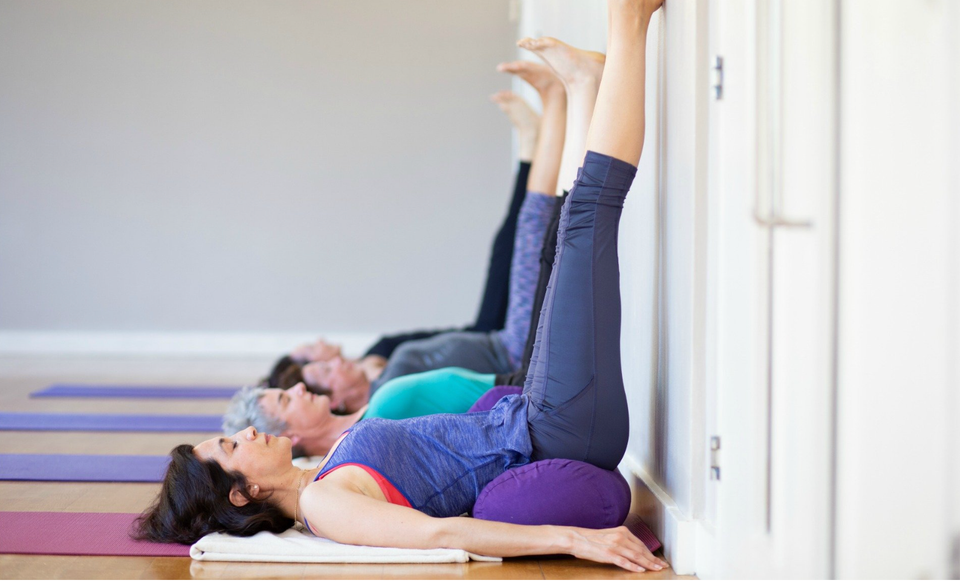
I mentioned in an early blog that in the autumn of 2024 I hit a bottom in terms of my perimenopausal symptoms. For almost four full years new symptoms had arisen every few months, mostly without resolution of preceding symptoms. It felt like rocks were being loaded into a bag I was carrying, and the more I learned about the health risks of being postmenopausal, the more hopeless and frantic I felt.
In October 2024, after a month of regular emotional meltdowns, I had a come-to-Jesus moment with myself. I knew that if I did not actively choose some way in which to reframe my menopause transition and start to interact with it more creatively and constructively, I would continue to deteriorate physically and mentally.
Interestingly, the first thought that occurred to me was to seek out a yoga training focused on menopause. Although when I first started teaching yoga in 2000 my motivation was to support and guide others in learning about and caring for their bodies and themselves, the practice of teaching had always ended up being inspiring, nourishing, and supportive of my own self-awareness, care, and creativity. I reasoned that in helping others who were on the menopause journey, I might be able to both turn my attention productively outward and also better meet my own needs.
Within a few minutes of searching online, I found a Menopause Yoga teacher training based in the UK and offered virtually. In November 2024 I completed a five week, forty-hour training with Petra Coveney, the developer of Menopause Yoga™.
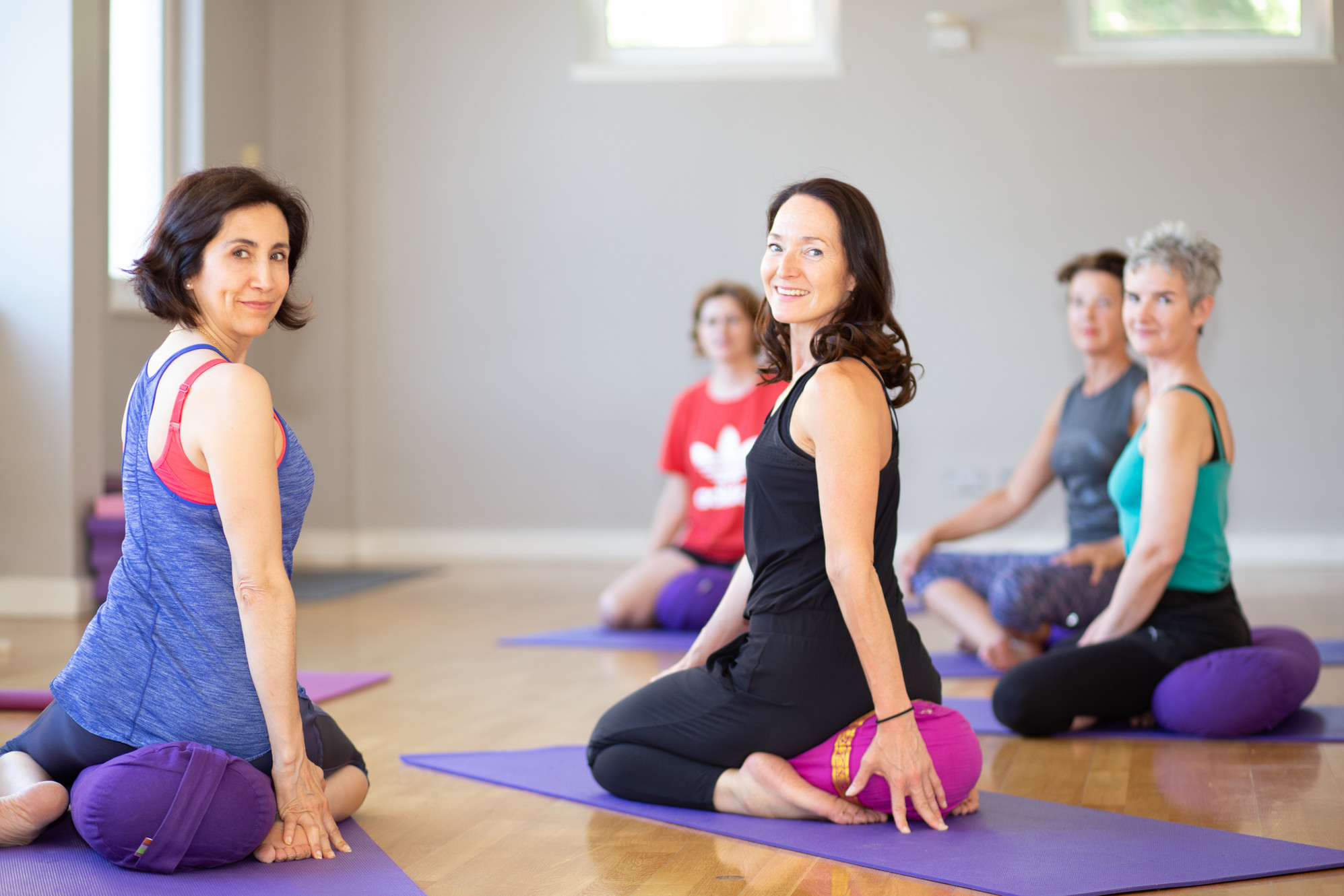
Petra created her system of Menopause Yoga in response to her own needs. She entered perimenopause in her early 40s and found that there was very little information or support for women going through menopause at any time of life. To address this lack, she did research in the eastern traditions of yoga, Ayurveda, and Traditional Chinese Medicine (TCM) as well as investigating what western medicine and science had to offer on the subject. She designed Menopause Yoga specifically to
· EDUCATE women about menopause
· Provide a positive vision of menopause that women can EMBRACE
· EMPOWER women to move through this transition into a strong, healthy, and powerful postmenopause
What is unique about Petra’s Menopause Yoga™ is the incorporation of Ayurvedic and TCM frameworks that view the physiological and psychospiritual changes of menopause through more complex and natural lenses than the Western medical model offers. Learning more about the innate seasonal cycles of a woman’s lifetime and the energies that tend to prevail in each season provides a bigger picture that helps hold the intensity of certain life periods. This larger context also gives us access to multiple perspectives about what we’re experiencing so that we may see opportunities and gifts that might be naturally present in any given season and intuit how to align ourselves energetically to wisely cultivate that time.
Critically, Menopause Yoga™, in alignment with the Traditional Chinese Medicine view on menopause, reframes menopause as a woman’s Second Spring Awakening.

Being offered this alternative vision of what I was walking toward felt like a lifeline to me after so many years of what had felt like breakdown, dysfunction, and medical information that framed so much of what I was experiencing as senescence, deterioration, and infirmity.
Although Petra Coveney’s Menopause Yoga™ is the most structured and formally designed yoga system I have found to address the menopause transition, she is not the only one evolving yoga to meet the needs of women in mid-life.
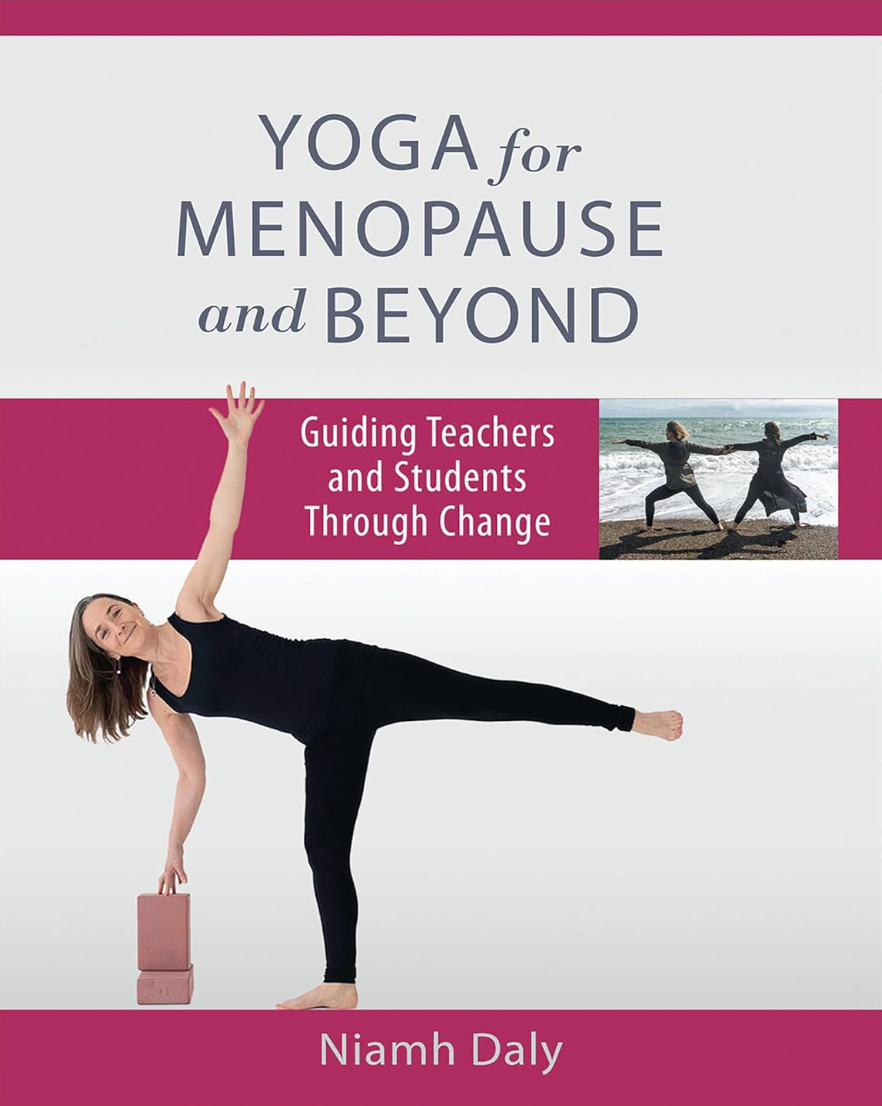
Niamh Daly, a yoga teacher from Ireland, has written a book called Yoga for Menopause and Beyond. In it, she discusses some of the physiological changes of menopause and provides information on how yoga can be helpful for certain perimenopausal symptoms, such as anxiety or insomnia, or for addressing health challenges, for example, pelvic floor and bone health. Her main thrust though is revisioning the yoga class, and both she and Petra do a great job of this.
What is the difference between yoga and yoga for menopause?
There are a few crucial differences between a typical mainstream yoga class and a yoga class designed specifically for people in the menopause transition:
The most critical difference is that in menopause yoga classes:
Yoga is explicitly reframed as a practice not only of self-care, but of health care, an instrument that promotes not only fitness and stress release, but systemic health and wellness
AND
Menopause is seen as a normal and healthy life passage and opportunity for growth, and women going through menopause are viewed as healthy, unique, powerful, whole, and blossoming
In addition:
· Yoga for menopause consciously uses asana (postures) and pranayama (breath work) to soothe and prevent perimenopausal symptoms and avoids postures and breathing exercises that may exacerbate and inflame symptoms.
o This is critical because the pace, environment (hot yoga, anyone?), orientation, and types of postures and breathing in many mainstream yoga classes are likely to make menopausal symptoms worse and work against the deep rest, relaxation, and slower pace that are essential to reduce and calm the naturally inflammatory state of perimenopause.
· Yoga for menopause tends to focus on postures that offer tension release, encourage deep rest and relaxation, and promote optimal organ and hormonal functioning.
o Classes for menopause will typically offer a variety of restorative asana, and even in more active postures props such as chairs, walls, and blocks may be used to promote relaxation even while building strength or balance. There is a recognition that yoga offers much more than the opportunity to tone muscle or burn calories. Yoga postures can help create space around the organs, rinse out and provide blood supply to various muscle groups and glands, and balance the nervous system. All of these things promote digestion and elimination, assist hormonal regulation, and decrease systemic inflammation.
· Like yoga postures, breath work in yoga classes for menopause is used specifically to address the needs of a body going through perimenopause. There are specific breathing practices—sometimes done alone, at other times done in rhythm with movement—that can soothe anxiety, cool hot flashes, promote calm and concentration, provide grounding and stability, build energy, and safely release the explosive energy of rage.
· And finally, a central practice of menopause yoga classes is the women’s circle, a safe and supportive space where women can speak to their experiences and be heard without judgment. Building community and cultivating support networks for women, so that we can break the cultural stigma and silence around a universal female experience that is often considered shameful and taboo, is being established as a primary building block of yoga for menopause.

Some science behind yoga for menopause
Overall, yoga practices do seem to confer benefits for menopausal women. Specifically, yoga has been shown to help improve sleep, alleviate anxiety and depression, reduce stress levels, improve cholesterol and blood glucose levels, ameliorate vasomotor, sexual, and psychosocial symptoms, and increase overall quality of life (Gangadharan et al., 2024; Khadka et al., 2022).
Recent systematic reviews and meta-analyses, as well as specific randomized controlled trials (RCTs), consistently demonstrate that yoga, an inexpensive, non-invasive practice that may offer benefits far beyond the alleviation of menopausal symptoms, can support well-being through menopause.
An RCT done by Khadka et al. (2022) looked specifically at the effects of yoga on estrogen, progesterone, luteinizing hormone (LH), and follicular stimulating hormone (FSH) levels in perimenopausal women. Sixty women were divided into two groups: yoga and control. Both groups were comparable at the start of the study in terms of BMI (body mass index), blood pressures, heart rate, and respiratory rate.
The yoga group practiced meditation, pranayama, and a few simple postures for 40 minutes/day, 6 days/week and the control group did no yoga as usual. After four weeks the results were impressive:
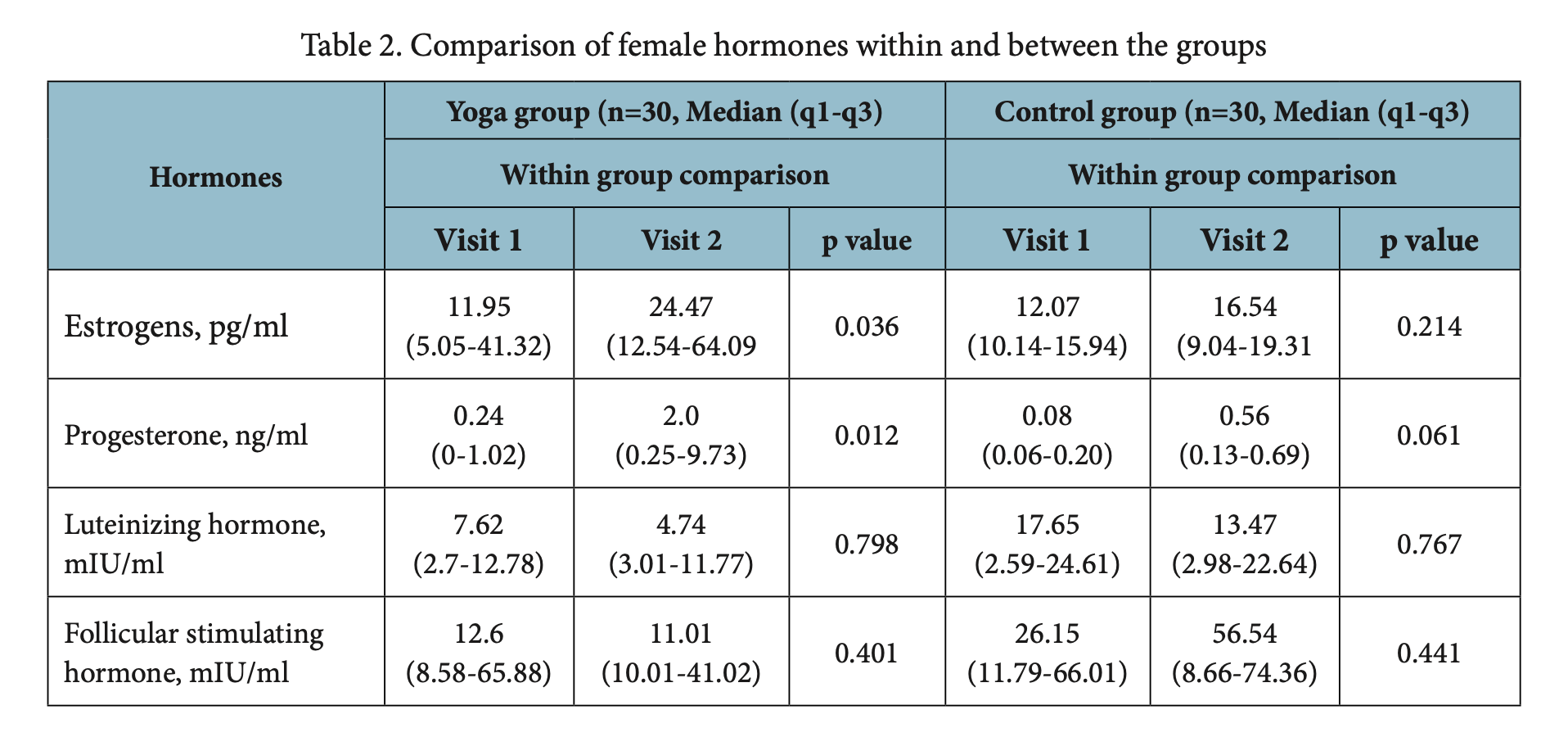
The estrogen and progesterone levels increased significantly in the yoga group, while the control group’s levels stayed low. What I also found interesting is that changes in the LH and FSH were mild in the yoga group but were much larger in the control group. The control group started with higher numbers of these two hormones, but the drop in LH and increase in FSH in this group were also more dramatic over the four weeks compared with the yoga group. This makes me wonder if there might have been more fluctuation or hormonal instability generally for the control group.
In this same trial the researchers also measured total cholesterol, LDL and HDL cholesterol, and triglyceride levels. They noted that there was a decrease in total and LDL cholesterol and triglyceride levels and an increase in HDL levels, indicating that yoga may provide cardiovascular protective effects. There was also a decrease in BMI after four weeks of consistent yoga practice.
Khadka et al.’s study is unusual in its focus on measuring hormone levels in connection with yoga practice. This makes it a particularly important study to consider and also expand on with further research.
The majority of studies emphasize subjective measures of yoga’s effects on vasomotor symptoms, mood changes, quality of life issues such as sleep and sexual problems, and musculoskeletal discomfort. In other words, most studies rely on questionnaires and women’s self-reports of their symptoms to evaluate how effective yoga is in impacting health and well-being.
In another RCT done by Abiç & Vefikuluçay (2024), there were 31 women in a control group and 31 women who practiced yoga for 60 minutes twice a week for 10 weeks. They used the Menopause Rating Scale (MRS) to measure somatic, psychological, and urogenital complaints. As you can see from the chart below, women in both groups were well-matched on their scores at the beginning of the study.
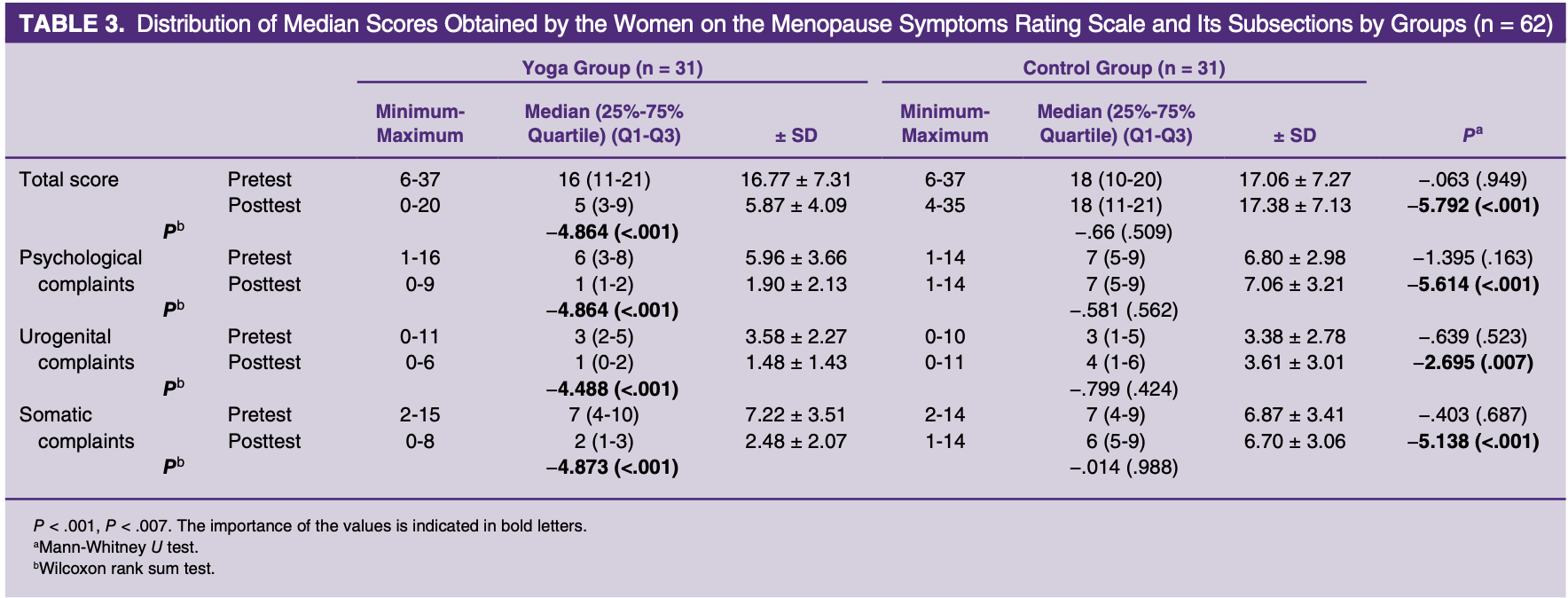
By the end of the ten weeks, scores differed drastically, with much improved scores for the women in the yoga group. Because urogenital symptoms tend not to be included in yoga research it is particularly important to note that there was statistically significant improvement in urogenital symptoms in the yoga group.
Badve et al. (2025) used eight psychologically oriented scales to measure how a control group of 50 perimenopausal women fared in comparison to 50 perimenopausal women who did 75-minute yoga sessions five days a week. Each yoga class included a combination of postures, breathing practices, meditation, and relaxation.
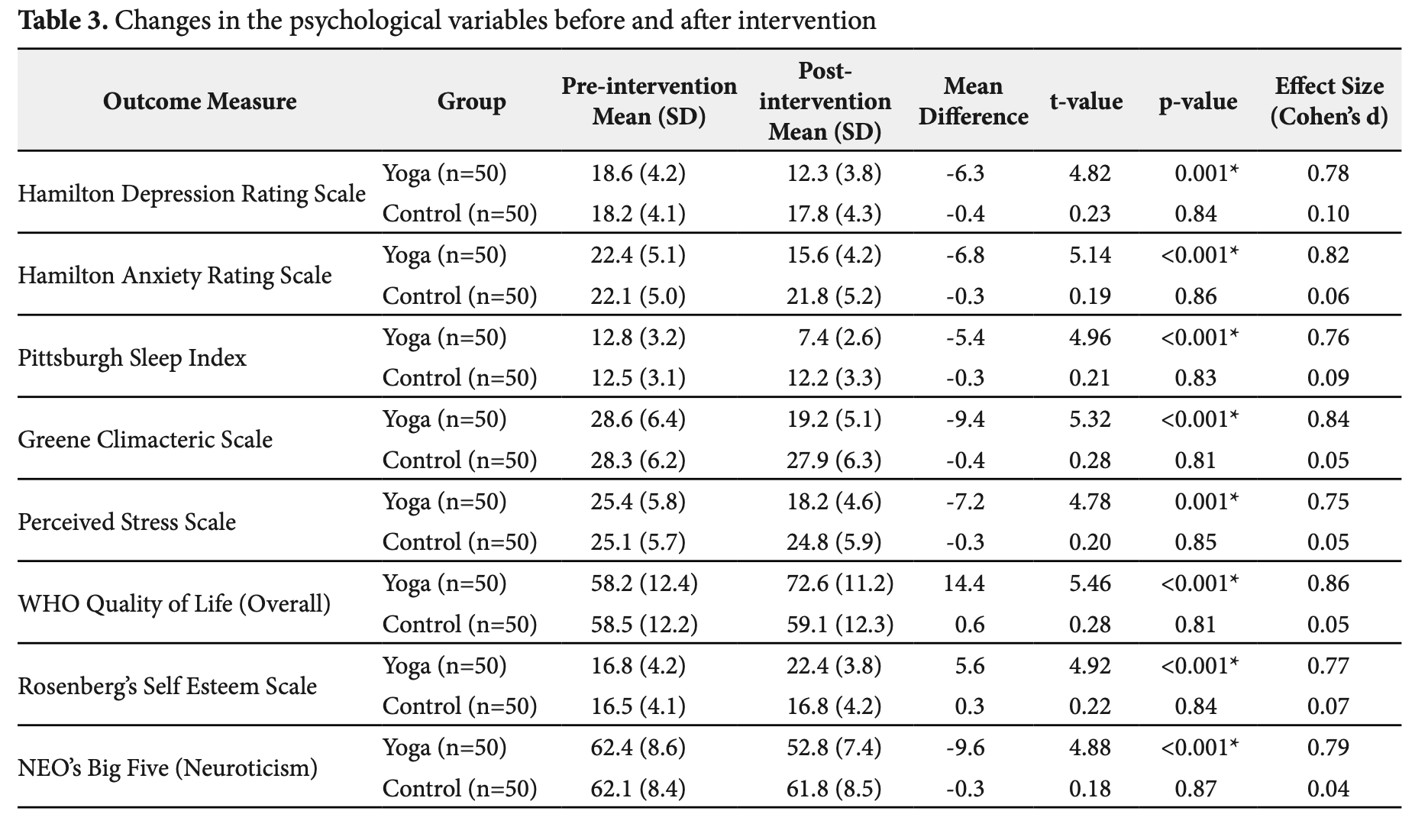
Again, you can see from the chart that the groups were fairly even in their questionnaire scores at the beginning of the study. By the end of it, the yoga group’s scores were improved by a statistically significant amount across the board.
The scores above can be a little confusing to read because some of the improvements read as higher scores and some as lower. The graph below illustrates the magnitude of effect pre- to post-intervention between the yoga and control groups.

This paper also referred to a 2014 study that found that perimenopausal yoga participants in a 12-week yoga program had significant improvement in physical, psychological, vasomotor, and sexual symptoms and also “exhibited superior improvements in overall quality of life compared to those in an exercise group” (Badve et al., 2025, p.336).
Brazilian researchers, e Souza et al. (2020), designed a study to look at how practicing yoga in premenopause affected women’s experience of menopausal symptoms. They compared a group of 28 women who had been practicing yoga for at least five years to 30 women who were regular strength training and/or aerobic exercisers and 50 women who were sedentary.
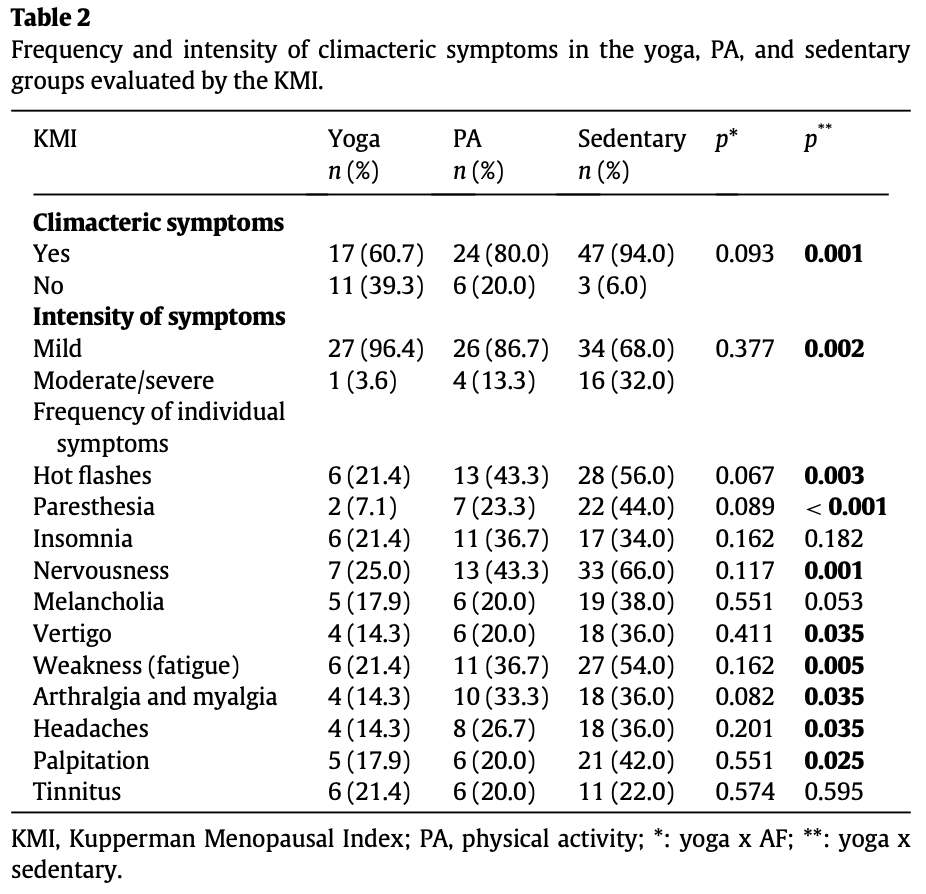
The yoga practitioners outperformed both the exercisers and the sedentary group in having both less frequency and lower intensity of menopausal symptoms as well as significantly better of quality-of-life measures. The only exception to this was tinnitus where the yoga group’s score was equal to the exercise group and better than the sedentary group’s score.
Interestingly, this study also found that most participants in the yoga group did not smoke or regularly use alcohol and also “reported a low rate of drug use and a low frequency of disease” (e Souza et al., 2020, p.71). The yoga group also used significantly fewer prescription drugs for physical and mental health conditions than either the exercise or sedentary group.
Challenges to discovering evidence of yoga's effectiveness
This points to some of the challenges involved in scientifically studying the benefits of yoga for particular conditions:
· How to define exactly what yoga is and what types of yoga work to confer physical and psychological benefits
· Figuring out and quantifying how much yoga works and for whom
· Pinpointing and scientifically elucidating the physiological and psychological mechanisms by which yoga works
Confounding factors
In the study by e Souza et al. (2020), most of the women included in the yoga group were yoga teachers, not students. As such, they were more likely to have immersed themselves in yoga as a lifestyle, aligning themselves with the ethical teachings and philosophies of yoga. These, in turn, would have an impact on their dietary choices, how they choose to address their healthcare needs, and their orientation toward stress and relaxation.
Although in the randomized controlled trials described above testing showed members of the control and yoga groups to be fairly well matched at pre-intervention stages, one of the ongoing challenges of comparing those who practice yoga regularly with those who do not is that there are potentially multiple confounding factors that may skew results. Essentially, those who persist on the path of practicing yoga tend to embrace philosophical, relational, dietary, and spiritual orientations, in addition to the physical practices, that can also have profound and positive effects on health and well-being. As a result, it is difficult to attribute the beneficial impact of their yoga practice to a specific set of physical postures or breathing practices.
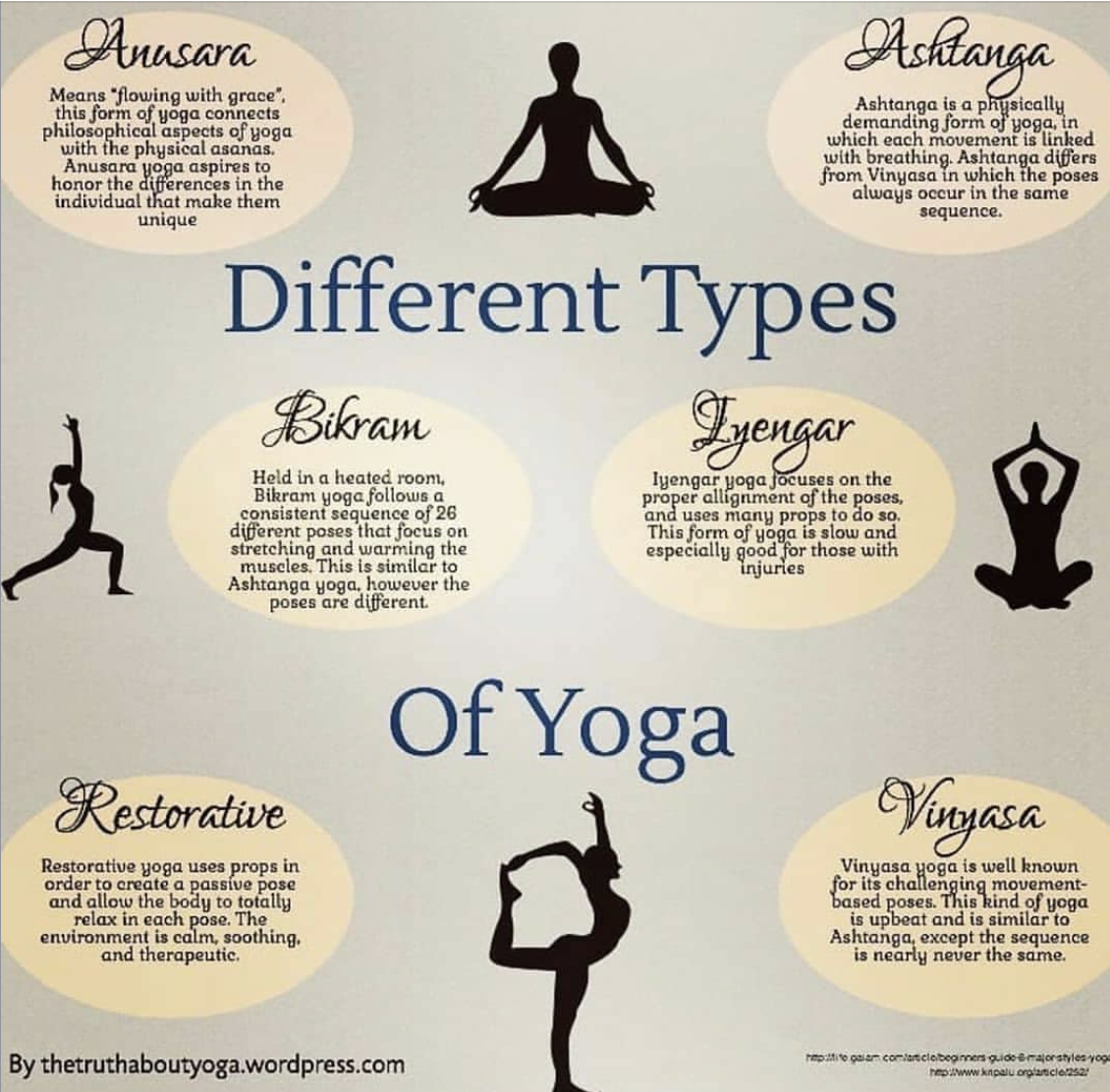
What works?
And speaking of a specific set of practices: It should be clear from looking at the studies above that there is not one sequence of particular postures, breath work, or meditation techniques, nor a certain number of days or minutes to practice, nor a particular style or lineage, that is necessary to follow to receive benefit from yoga.
Indeed, when I taught yoga full-time it was clear to me that even those students who only practiced yoga by coming to one 90-minute class a week for 8-12 weeks received benefits in the form of increased strength, greater flexibility, more ease in the body, increased body confidence and knowledge, consistent stress reduction, and more calm and emotional stability. And those were just the benefits they and I could see and speak to. Who knows what was happening to their hormones, neurons, immune cells, and microbiota?

How does it work?
An abundance of scientific evidence shows that yoga practices consistently demonstrate a tendency to downregulate sympathetic nervous system arousal and promote parasympathetic tone, reducing heart rate and blood pressure (e Souza et al., 2020). I think it likely that many in the medical and scientific communities do not yet appreciate how profound this core shift can be for promoting healing and well-being and diminishing inflammation and symptom proliferation.
However, it has to be acknowledged that “the physiological mechanisms underlying the results of yoga remain unclear” (e Souza et al., 2020, p.71). I think it also important to acknowledge that yoga has often been touted as a panacea, as if yoga practiced often enough or perfectly enough or with the “right” teacher will somehow keep aging, illness, and injury completely at bay.
I know from my personal experience with yoga and from watching hundreds of students flourish in practice that yoga can be an extraordinary gift for health and well-being. It is inexpensive, non-invasive, travels easily, can be made accessible for almost every single body, and the majority of the side effects are all beneficial. (The only exception being when yoga practices are forced or aggressive and create injury.)
I also know from personal experience that yoga has to be adapted to meet the needs of an individual’s changing body and mind. I suspect that if I had been able to sustain my yoga practice and figure out how to make it work for me earlier in my perimenopause I would have fared better physically and mentally. Instead, I fell out of connection with my practice, frustrated that the ways in which I had always practiced no longer felt good and left me tired and sore rather than energized and strong. My practice became sporadic, and it wasn’t until I started working with a yoga therapist at the beginning of 2024 that I was able to reconnect with a gentler, more responsive practice that felt better to me. The Menopause Yoga™ training deepened my understanding about the changes that needed to continue to evolve in order to make yoga relevant and nourishing for me once again.
We do not yet know exactly how yoga helps, but the evidence is that it does, and that it offers fairly large dividends on a small investment of time and energy. The trial by Khadka et al. (2022) showing increases in estrogen and progesterone after only four weeks of regular yoga is inspiring. We need to be cautious and aware that these hormones are always fluctuating erratically during perimenopause and the time period studied is brief.
But the results—in this, and every study described here—seem to me to be compelling enough that even if yoga can help one attain only a fraction of the benefits shown, it may be enough enticement to start practicing.

Cultural relevance
Other things to consider when studying yoga’s impact on health and well-being:
· The status and relevance of yoga within the culture and population being studied
· How yoga is practiced
· Which parts of yoga are emphasized, for example, physical postures, meditative techniques, or philosophy
How yoga is practiced, and which parts of yoga are emphasized in a certain culture or by a particular teacher will influence whether yoga is taken up as a lifestyle or simply a way to sweat out the alcohol consumed over the weekend.
In the United States, yoga in the mainstream has emphasized the physical postures and using yoga as a fitness practice. Nevertheless, there are many lineages that have taken root here and they each tend to emphasize certain aspects of yoga, from the scriptural to the meditative to the ethical to the physical and material practices.
Within the context of scientific studies, it might be important to consider how participants’ attitudes and beliefs about yoga—what it is, what it means, and what it’s for—might affect what they receive, or fail to receive, from a yoga practice.
What’s being measured?
The study on yoga and hormones by Khadka et al. (2022) was interesting, in part, because it specifically measured blood hormone levels. It gave us quantifiable data. This is beneficial because it gives us definite, irrefutable data in the form of numbers and because it is easy to compare numbers to each other across studies, thus paving the way for future studies building on this one.
As I mentioned previously, most of the studies use questionnaires, scales, and indices that also give us numbers and statistics, but that are based on subjective responses rather than objective measures like those gleaned from blood work.
This type of data is also important, not least because of the consistent message that repeatedly comes up as I explore the research around menopause.
The message?
It is essential to ask the woman in front of you
· what she is experiencing,
· how she is experiencing it,
· what it means to her,
· and what she thinks and feels would be the best way to handle her experience
Over and over again in the papers and books I have read, researchers come to the conclusion that, no matter how helpful the data based on aggregate information may be, it is unlikely to be an adequate substitute for working with the individual woman in front of you and treating her as the expert on her situation. In other words, you are the expert on your situation.
Conclusion
When I was taking my 1,000-hour yoga teacher training in 2001, I remember my teachers describing the myriad extraordinary health benefits of yoga as “side effects.” From their perspective and the perspective of their Indian teachers in the Iyengar tradition, yoga was first and foremost a system of spiritual practices. The physical practices were designed primarily to make the body limber and strong enough to sit for long periods of time in uninterrupted meditation, making it more likely to reach advanced stages of concentration and absorption.
I have always marveled at the power of these “side effects.” There is no doubt in my mind of the physical and psychospiritual benefits of yoga for the body and mind at any stage of development. At the same time, to be helpful rather than harmful, yoga has to be adapted for the developmental stage, energy level, and physiological and psychological needs of the body and mind in each time of life.
This can be a delicate balancing act. Sometimes, we can demand that the potent and challenging practices which we engage to heal and transform become easier, simpler, or less time consuming in order to fit into the habits, tastes, and routines we already have. Rather than stretching and changing ourselves to meet the challenge of the practices, we get them to conform to us as we already are and lose our opportunity for transformation. One of the miracles of yoga is that it can—mindfully—be readily adapted without losing its power to sustain and promote health on multiple levels. Another miracle is that “yoga” encompasses so much that can be of help to any person regardless of their current condition, ability level, or need:
· physical postures that range from fully supported and supine to upside down on the hands or head
· breathing practices that raise flagging energy, release surplus energy, enhance digestion, sharpen concentration, or prepare the body/mind for rest
· ethical practices that cultivate connection, community, self-awareness, and self-discipline
· meditative practices that enhance connection to the divine and bring the individual into a different relationship with life and source
· scriptural study and philosophical reflection (jnana yoga)
· acts of service (karma yoga) and devotion (bhakti yoga)
If you are suffering from perimenopausal symptoms that are interfering with your health and well-being, or if you are simply finding that the old ways of moving, exercising, stretching, and achieving stress and tension release are not working for you as they did, you may want to seek out a yoga class geared toward menopause. Make sure to ask the teacher about their experience and training. Safety and support are key ingredients in any yoga class and, as I stated earlier, they are essential building blocks of yoga for menopause.
If you have any questions about yoga in general or yoga for menopause specifically, please reach out: beingthechange.us@gmail.com. And if you’d like me to visit your community and teach Menopause Yoga™ workshops, please let me know.
References
Abiç, A., & Vefikuluçay, D. Y. (2024). The effect of yoga on menopause symptoms: A randomized controlled trial. Holistic nursing practice, 38(3), 138-147. DOI: 10.1097/HNP.0000000000000646
Badve, R., Varadharajan, E., Govindasamy, K., Dongre, S., Velusamy, S., Valappil, I. N. K., ... & Geantă, V. A. (2025). Considering the Impact of Yoga on Psychological Well-being and Quality of Life in Perimenopausal Women: A Randomized Controlled Trial. Physical Education Theory and Methodology, 25(2), 331-339. https://doi.org/10.17309/tmfv.2025.2.14
Coveney, Petra. (2022). Menopause Yoga. Singing Dragon.
Daly, Niamh. (2025). Yoga for Menopause and Beyond. Human Kinetics.
e Souza, L. A. C., Reis, I. A., & Lima, A. A. (2022). Climacteric symptoms and quality of life in yoga practitioners. Explore, 18(1), 70-75. https://doi.org/10.1016/j.explore.2020.09.005
Gangadharan, S., Arulappan, J., Matua, G. A., Bhagavathy, M. G., & Alrahbi, H. (2024). Effectiveness of yoga on menopausal symptoms and quality of life among menopausal women: a systematic review. International Journal of Nutrition, Pharmacology, Neurological Diseases, 14(3), 300-316. DOI: 10.4103/ijnpnd.ijnpnd_23_24
Khadka, R., Paudel, B. H., Lamsal, M., Shrestha, N., Regmi, M. C., Chhetri, S., & Karki, P. (2022). Effect of yoga on female hormones in peri-menopausal women. Journal of Physiological Society of Nepal, 3(1), 15-21. https://doi.org/10.3126/jpsn.v3i1.57764
Image References
Title: https://triyoga.co.uk/blog/yoga/menopause-yoga/
Women's Circles: https://www.pinterest.com/pin/162622236528130454/
Types of yoga: https://www.facebook.com/asthayoga.vn/posts/different-types-of-yoga-%EF%B8%8F/1109804266036514/
